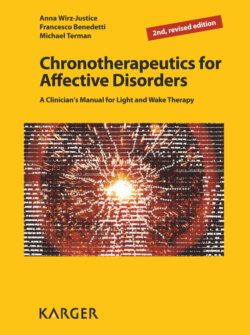Читать книгу Chronotherapeutics for Affective Disorders - M. Terman - Страница 13
На сайте Литреса книга снята с продажи.
1.3 Principles of Circadian Timing
ОглавлениеThe circadian system [5] is schematically described in figure 3. A master pacemaker or biological clock in the hypothalamic suprachiasmatic nuclei (SCN) drives all circadian rhythms in the brain and body. The endogenous clock ticks at a period different from, usually slightly longer, than 24.0 h. The SCN is synchronised to the solar cycle primarily by retinal light input. This retinal signal is transmitted by a specialised (‘non-visual’) retino-hypothalamic tract (RHT) to the SCN . A subset of retinal ganglion cells contains the photopigment melanopsin, which responds to light energy independently of the classic photoreceptors, rods and cones [6]. While melanopsin is selectively receptive to short wavelength blue light, the cones modulate the ganglion cell response. There is strong evidence for a circadian clock in the mammalian eye as well, which rhythmically gates light input to the SCN [7, 8].
Fig. 4. Natural progression of dawn on May 5 (a typical date of spontaneous remission of winter depression). Screen shot from software used to drive dawn simulation in the bedroom. For therapeutic use, the entire curve is attenuated from 800 lx at sunrise to 300 lx or lower, depending on dose adjustment. Time of sunrise is initially adjusted to habitual wake-up time (end of subjective night) and gradually moved earlier if additional circadian rhythm phase advances are indicated (from Terman and Fairhurst, Columbia University).
Fig. 5. Example (schematic) of a melatonin rhythm measured in saliva at baseline (full line) and after phase shifts to timed zeitgebers (light or melatonin; dotted line).
Only in the last decades has it been recognised that light is the major zeitgeber (time-giver or synchronising agent) for human circadian rhythms, being much more powerful than social zeitgebers, such as the alarm clock [9]. Environmental light spans nine orders of magnitude, from starlight to the sun overhead at midday (fig. 4). Normal room light falls into the range of civil twilight, between 100 and 300 lx. By contrast, earliest daylight with the sun rising over the horizon provides about 800 lx, and noontime light can reach 100,000 lx. Bright light therapy administers full daylight levels up to 10,000 lx, far above normal home or workplace lighting. The circadian system has evolved to respond to the natural dawn signal preceding sunrise.
Fig. 6. Schematic representation of shifts (in hours) in the circadian system according to time of day (or circadian phase) of administration. Light (full line) given in the early morning (after the core body temperature minimum at approximately 5 a.m.) shifts the clock earlier (phase advance), in the evening (before the core body temperature minimum) to later (phase delay). Melatonin (broken line) has nearly opposite effects: morning melatonin induces a phase delay, and evening melatonin a phase advance. Redrawn from [15, 16], with permission.
Nocturnal production of the pineal hormone melatonin is driven by the SCN ; melatonin also feeds back on melatonin receptors in the SCN and thus, like light, can act as a zeitgeber to phase shift and synchronise circadian rhythms [10] (fig. 3). As befits a ‘darkness hormone’, melatonin acts in a manner opposite to light. Light suppresses melatonin and thus modulates its nocturnal secretion [11]. In most mammals, melatonin acts as a seasonal signal through change in duration – long secretion in the long nights of winter, short in the short nights of summer. Moreover, when melatonin is administered before SCN-triggered pineal melatonin onset in the evening, it elicits phase advances of the circadian clock in the same manner as early morning light exposure. Conversely, when melatonin is administered in the morning, it elicits phase delays, as does evening light exposure (fig. 5).
A serotonergic pathway from the raphe nucleus provides non-photic input to the SCN [12]. Non-photic zeitgebers such as exercise, sleep or darkness are probably much weaker zeitgebers than light on SCN function [12]. Social zeitgebers (such as school or work schedules) may act directly or indirectly on the SCN , since they determine the timing of meals, sleep, physical exercise and outdoor light exposure. The circadian pacemaker has inputs to and from sleep regulatory centres [13] (section 1.4.). In addition to the primary biological clock in the SCN , we now know that circadian oscillators are found in every organ and every cell – the so-called peripheral clocks [5].
Since light and exogenously administered melatonin are major zeitgebers for the SCN , it is important to understand how they need to be administered to obtain the required result. The principle of how zeitgebers work is timing: the same amount of light or melatonin can shift the biological clock to earlier or later, depending on when it is given (fig. 5). These effects are summarised in a ‘phase response curve’ that illustrates how much of a phase shift (advance, delay, or no effect) can be induced at different times of day (or circadian phase) (fig. 6). To shift the clock earlier, morning light and/or evening melatonin are effective [11, 14-16]; to shift to later, evening light and/or morning melatonin [11, 14-16]. Thus, timing is crucial for the optimal response. Moreover, it is important to note that a given clock time of administration is not necessarily the same ‘internal clock time’ for every person (particularly if circadian rhythms are disturbed, as we discuss in sections 2.2. and 4.2.).
Fig. 7. Two-process model of sleep regulation. The homeostatic process S rises during wake and declines during sleep. The circadian process C (here described by two thresholds for going to and waking from sleep) determines the timing and architecture of sleep. S = Sleep; W = wake. From Daan et al. [20], with permission.
Phase-resetting and melatonin-suppression responses are also dose dependent and non-linear; shorter light exposures are more efficient [17], as are intermittent pulses [18]. Within limits, increasing duration is more effective than increasing light intensity [19].
